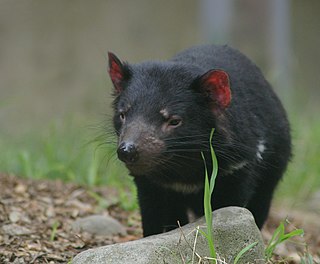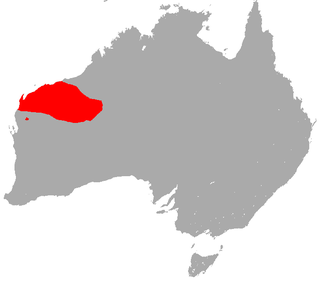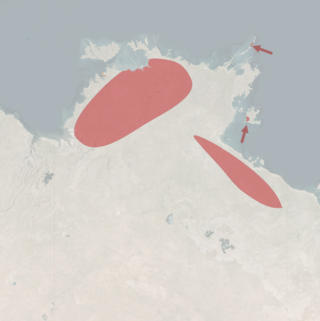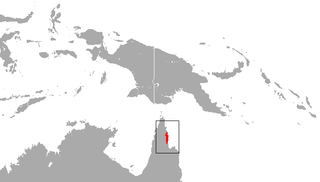
Kroombit Tops is a national park in Central Queensland, Australia. It is between Monto and Calliope. It is two parts. The largest part is within the localities of Tablelands, Valentine Plains, Cania and Boyne Valley, while the smaller part is in the locality of Mount Alma. It is 399 km northwest of Brisbane. Cania Gorge National Park is located approximately 25 km to the south.

The Dasyuridae are a family of marsupials native to Australia and New Guinea, including 71 extant species divided into 17 genera. Many are small and mouse-like or shrew-like, giving some of them the name marsupial mice or marsupial shrews, but the group also includes the cat-sized quolls, as well as the Tasmanian devil. They are found in a wide range of habitats, including grassland, underground, forests, and mountains, and some species are arboreal or semiaquatic. The Dasyuridae are often called the 'marsupial carnivores', as most members of the family are insectivores.

The little red kaluta is a small, reddish-brown, shrew-like mammal native to dry grasslands of northwest Western Australia. It is active at night, feeding on insects and other small animals. The kaluta is a marsupial and is the only member of its genus, Dasykaluta. Individuals are around 10 cm (3.9 in) long and weigh from 20 to 40 g. They live for about four years in captivity. Other common names include little red antechinus, russet antechinus and spinifex antechinus.

The yellow-footed antechinus, also known as the mardo, is a shrew-like marsupial found in Australia. One notable feature of the species is its sexual behavior. The male yellow-footed antechinus engages in such frenzied mating that its immune system becomes compromised, resulting in stress–related death before it is one year old.

Antechinus is a genus of small dasyurid marsupial endemic to Australia. They resemble mice with the bristly fur of shrews.

The slender-tailed dunnart, also known as the common dunnart in Australia, is a dasyurid marsupial. It has an average body length of 7 to 12 centimeters (2.8–4.7 in) with a tail length of 5.5 to 13 centimetres (2.2–5.1 in). It weighs 25–40.8 grams for males and 16.5–25.4 grams for females.

The white-tailed dunnart, also known as the ash-grey dunnart, is a dunnart native to Australia.

The fat-tailed false antechinus, also called the fat-tailed pseudantechinus and red-eared antechinus, is a member of the order Dasyuromorphia. It is an inhabitant of western and central Australia. Its species name, macdonnellensis, refers to the MacDonnell Ranges near Alice Springs, where it was first discovered.

The sandstone false antechinus, also known as the sandstone pseudantechinus, the sandstone antechinus, the sandstone dibbler, Harney's antechinus and the Northern dibbler, is a species of small carnivorous marsupial, which has a patchy distribution in Australia's Northern Territory.

Rory Cooper's false antechinus, also known as the tan false antechinus and the tan pseudantechinus, is a recently named species of small carnivorous marsupial which inhabits rocky outcrops in Western Australia. Nothing is known of its behaviour but it is expected that this will be similar to other members of the false antechinus genus. A study published in 2017 found no support for separation as a new species of Pseudantechinus, and the name was proposed to be synonymous with the previously described Pseudantechinus macdonnellensis.

The subtropical antechinus is a species of small carnivorous marsupial of the family Dasyuridae.

The Atherton antechinus, also known as Godman's antechinus, is a species of small carnivorous, insectivorous marsupial native to Australia. It is one of the rarest members of its genus, and differs from other antechinuses in its more rufous body colour and small eyes.

The cinnamon antechinus, also known as the Iron Ranges antechinus and the Cape York antechinus, is a species of small carnivorous marsupial of the family Dasyuridae. It is the only mammal endemic to Cape York Peninsula, being confined to semideciduous forest around the McIlraith and Iron Ranges. Along with the Atherton antechinus, it is the rarest in its genus.

The brown antechinus, also known as Stuart's antechinus and Macleay's marsupial mouse, is a species of small carnivorous marsupial of the family Dasyuridae. The males die after their first breeding season, and the species holds the world record for being the world's smallest semelparous mammal.

The dusky antechinus, also known as Swainson's antechinus or the dusky marsupial mouse, is a species of small marsupial carnivore, a member of the family Dasyuridae. It is found in Australia.
The Kroombit tinker frog, also sometimes referred to as Pleione's torrent frog, is a species of frog in the family Myobatrachidae. It is endemic to Central Queensland in Australia. It lives among rocks and leaf litter near small flowing streams.
Antechinus arktos, the black-tailed antechinus, is a species of small carnivorous marsupial native to Australia.
The buff-footed antechinus is a species of marsupial.
Patricia Woolley is Australian zoologist recognised for her work with marsupials, specifically the dasyurid family. Pseudantechinus woolleyae is named for her.
Antechinus vandycki, the Tasman Peninsula dusky antechinus, is a species of marsupial in the family Dasyuridae. It was first described in 2015 by Andrew Baker and his group of scientists in southeast Tasmania. In October 2021, only eight specimens were known.















